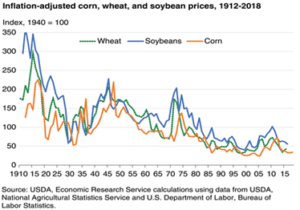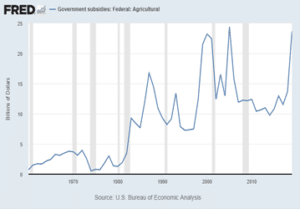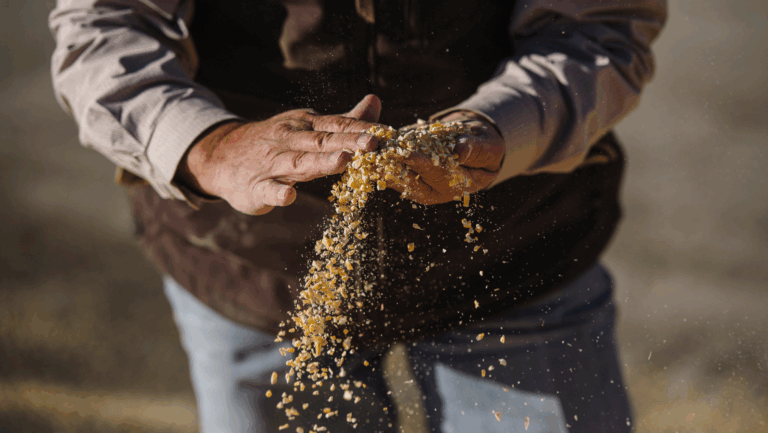Balancing Agricultural Supply and Demand
Why is supply and demand management important and how does it impact farm profits?
Imagine a food system that balances the needs of everyone including farmers, workers, processors, distributors, and retailers while providing nutritious and affordable food for every community. This concept is ambitious, but it isn’t out of our reach. It begins with an open discussion on legislative and trade reform that prioritizes the establishment of a stable and resilient family farm economy while continuing to meet the needs of consumers all over the world.
Prior to the Industrial Revolution, the key challenge for U.S. agriculture was producing enough food to feed everyone. Through technological advancements over the years, American farmers and ranchers have been able to produce more food on less land than ever before. In fact, U.S. farm output increased by 170 percent from 1948 to 2015.
Unfortunately, overproduction of agricultural goods has created unintended repercussions in the market such as,
- Suppressed crop prices;
- Consolidation of the industry;
- An increasing reliance on federal subsidies; and
- A widening poverty gap in rural communities.
The Role of Agriculture in Rural Community Development
According to the USDA, the rural poverty rate was 16.4 percent in 2017, compared with 12.9 percent for urban areas. One contributing factor is the difference in employment growth rates between urban and rural areas. Urban employment has grown steadily at about 1.6 percent per year since 2009. Comparatively, rural employment has grown at about 0.5 percent per year, with periods of stagnation from 2012 to 2016. Adverse commodity prices can have a disproportionate impact on farming-dependent counties, which accounts for 20 percent of total rural counties.
So how do we close this widening gap? Although a complicated process that takes time to trickle through communities and take effect, one way to help shrink this employment opportunity divide is the creation of steady rural jobs with livable wages. Agriculture, food, and related sectors contribute to this endeavor with 22.2 million American jobs—nearly 11 percent of total U.S. employment. For every $1 billion of U.S. ag exports, an estimated 7,500 full-time civilian jobs are created, making agriculture a critical part of rural community development.
However, in order to improve the employment rate in rural communities, we must create a supply management structure that empowers farm operations of all sizes to earn the market-based income needed to support their family, workers, and communities. At the same time, part of supply management also involves balancing the needs of consumers to ensure access to affordable food to prevent potential exacerbation of poverty levels. The concept of supply and demand management is nothing new, yet requires innovative solutions to find a way that benefits both the farmer and consumer. The deeper you dive into the topic of agricultural supply and demand management, the more you realize the complexity that exists within it.
Common Misconceptions Surrounding Agricultural Supply Management
Misconception #1: Overproduction of food for consumers will reduce world hunger.
While 10 percent of Americans are food insecure, 40 percent of food in the U.S. goes to waste. This realization implies that hunger is not a supply issue, but a poverty one. Not only is overproduction not solving world hunger, but this excessive waste of the food farmers work tirelessly to grow is contributing to soil erosion, water depletion, and rural poverty.
Misconception #2: More food equals more profit for farmers.
Rather than improving the profit margins for family-owned farm operations, overproduction has led to consolidation within the industry. In 1935, there were more than six million farms in the U.S., but today, that number has shrunk to just over two million. The flooding effect of the market has suppressed commodity prices, cut into farm profit margins, and pressured farmers to make more for less in order to stay in business.
Misconception #3: Supply management would negatively impact the agricultural global trade market.
Through trade agreements that prioritize supply management and fair worker wages, U.S. family-owned farms could actually become more competitive in the global market. However, this would take global collaboration and collective supply management action. Although difficult to achieve, global supply management policies interwoven into trade agreements could benefit the U.S. ag export sector by leveling the playing field, raising farmworker standards in other countries, and preventing multigenerational family farm operations from being pushed out of the industry due to supply surpluses and price suppression.
Misconception #4: Federal supply and demand management gives the government more control over our food.
Part of what makes us proud to be Americans is the freedom on which this country was fought for and founded. Our love for liberty has led to understandable resistance to supply management programs that were seen by some as regulatory control over how farmers can farm. While not perfect by any means, these programs helped establish fair commodity prices in the market. Unfortunately, their inconsistencies created slippage as they set limitations on farmable acreage. Over the years, they were retracted from federal policy and commodity prices declined through overproduction that failed to adjust alongside inflation. This flooded the agricultural market and led to a steady increase in federal farm subsidies that made American farm operations more reliant on government programs than ever before.
farm. While not perfect by any means, these programs helped establish fair commodity prices in the market. Unfortunately, their inconsistencies created slippage as they set limitations on farmable acreage. Over the years, they were retracted from federal policy and commodity prices declined through overproduction that failed to adjust alongside inflation. This flooded the agricultural market and led to a steady increase in federal farm subsidies that made American farm operations more reliant on government programs than ever before.
While the disruptive events in 2020 have been truly unprecedented, federal farm subsidies have been on the rise and skyrocketed to nearly 40 percent of estimated farm income this year. These subsidies are often disproportionately  distributed to the top ten percent of large agribusinesses and leave out the smaller operations that likely need it the most. For example, farmers who rent their land do not qualify for a large majority of these subsidy programs. Federal programs have their place and can offer a safety net for unpredictable events or assist in the financing of regenerative farming practices to improve operational resilience. However, ongoing ad hoc payments increase farmers’ reliance on the government rather than support the development of a strong and fair commodity market.
distributed to the top ten percent of large agribusinesses and leave out the smaller operations that likely need it the most. For example, farmers who rent their land do not qualify for a large majority of these subsidy programs. Federal programs have their place and can offer a safety net for unpredictable events or assist in the financing of regenerative farming practices to improve operational resilience. However, ongoing ad hoc payments increase farmers’ reliance on the government rather than support the development of a strong and fair commodity market.
AgAmerica is a Proud Advocate for the American Family Farm
From COVID-19 to global trade uncertainty, 2020 has given us serious grief but also valuable perspective in the U.S. agriculture sector. It highlighted the importance of industry deconsolidation, rural infrastructure development, and the need for American farmers to make livable wages with minimal reliance on federal assistance. Although none of these topics hold a simple solution, they are being discussed and prioritized at a federal level now more than they were in a pre-COVID world. It is essential for a diverse panel of American farmers to have a seat at the table when it comes to agricultural policies to create legislative reform that will mutually benefit the farmer, consumers, workers, and everyone in between.
As proud supporters of the American family farm and all that they represent, AgAmerica pushes the boundaries of traditional financing with a singular focus on agricultural land finance. Through our flexible loan spectrum, we are able to construct loans customized to the unique needs of American farm operations across the nation to help them thrive in the good times and sleep well during the tough ones. Founded with deep roots in the agricultural community, we understand the volatility farmers face each day and stay committed to supporting and advocating for their essential role in our society.
Contact one of our land lending specialists today to learn more about how our flexible financing offers stability in market volatility and ensures the long-term success of family farms across the nation.







